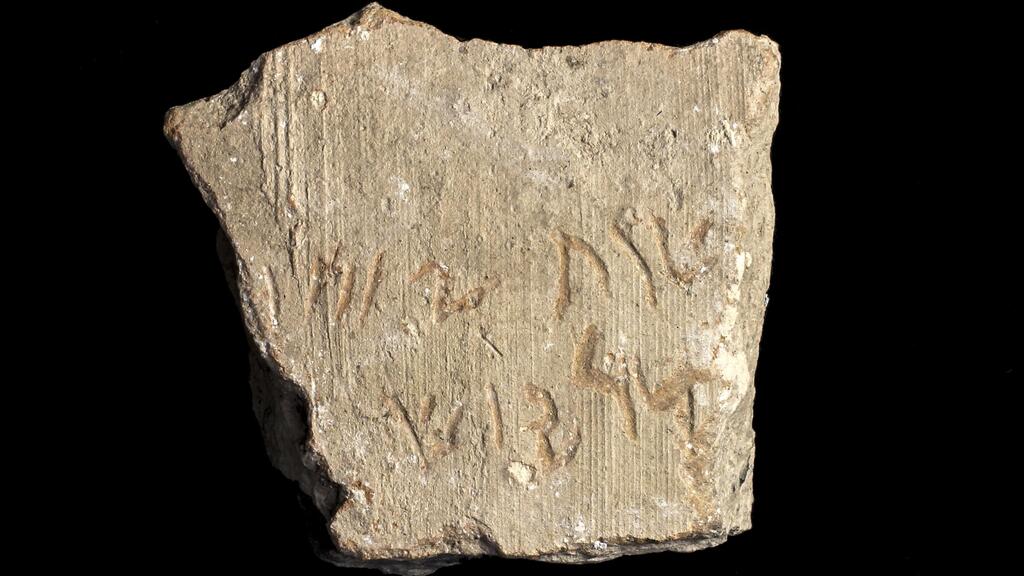Getting your Trinity Audio player ready...
A rare inscription bearing the name of Persian King Darius the Great was recently uncovered in central Israel.
Darius the Great was the father of King Ahasuerus - the biblical Achashverosh from the story of Purim. The inscribed sherd may represent a note acknowledging the dispatching or receipt of goods.
In December 2022, Eylon Levy, current international media advisor to President Isaac Herzog, visited the Tel Lachish National Park with a friend and chanced upon a small potsherd with some inscribed letters.
When they reported it to the Israel Antiquities Authority, the ostracon was examined in the advanced analytical laboratory and studied by Saar Ganor of the Israel Antiquities Authority and Dr. Haggai Misgav of the Hebrew University of Jerusalem.
It was later revealed that the inscription corresponds to the activities of the royal administration in the region during the time when Israel was controlled by Persia.
According to the Antiquities Authority, the inscription is written in Aramaic and was carved around 2,500 years ago, bearing the date "24th year of Darius," referring to the Persian King Darius the Great, the father of Xerxes I known from the Book of Esther - which is read annually on the Jewish holiday of Purim.
This is the first discovery of an inscription bearing Darius the Great's name found anywhere in Israel. During his long reign (522–486 BCE), the Persian Achaemenid Empire expanded, reaching its greatest extent under his son Hishrash (Ahasuerus, Xerxes in Greek), who ruled most of the ancient world.
3 View gallery


Inscription mentioning Darius the Great
(Photo: Yuli Schwartz, Israel Antiquities Authority)
With the accession of his son, Xerxes I, to the throne, the Persian Empire reached its peak and controlled large parts of the Eastern Mediterranean, and even reached India.
"When the Antiquities Authority called to tell me what they'd discovered, my heart started pounding," Levy recounted. "I was sure I was being pranked."
According to Ganor and Dr. Misgav, "During the excavations of a British expedition in the area nearly 90 years ago, an impressive Persian administrative structure was uncovered, built on the ruins of a palace built by Jewish kings. In the structure, magnificent courtyards and halls were exposed, with unique column bases that have only been found in Iran so far.”
According to the researchers, 15 years after the inscription was written, the events described in the Book of Esther took place.
The British expedition dismantled the remains of the Persian structure to dig up the palace below, and apart from the column bases, no remnants of this structure remained in the Tel Lachish National Park area. The inscription was located in the park’s area where the structure once stood.
3 View gallery


Inspecting the ancient inscription
(Photo: Sa'ar Ganor, Israel Antiquities Authority)
According to Antiquities Authority, the inscription was most likely an administrative seal of approval used in trade. Further, the date of the inscription could be dated to 498-7 B.C. due to it describing the number of years of Darius’ rule.
Back then, Israel was part of the Persian empire and offered taxes in the form of agricultural products as was the custom in the area. The area near Tel Lachish National Park was an important Judean city where temples were built and the taxes were collected.
The short inscription joins very few others found from the era of the Persian empire, and is one of the oldest inscriptions ever discovered in Israel.
“It’s amazing that hikers randomly find a rare inscription that connects to Darius the Great,” Antiquities Authority head Eli Escuzido said. “Darius’ son, Xerxes I, probably didn’t think evidence of his father’s rule will be found in Israel 2,500 years later.”


